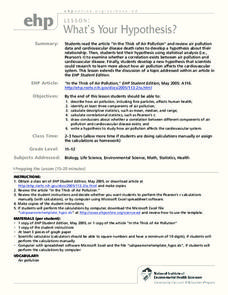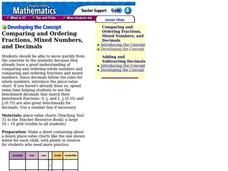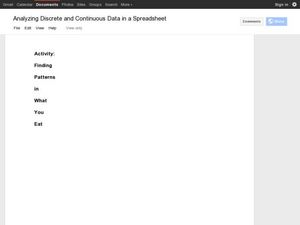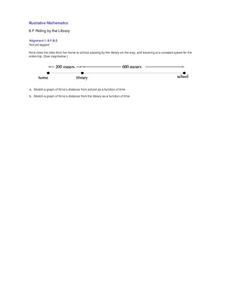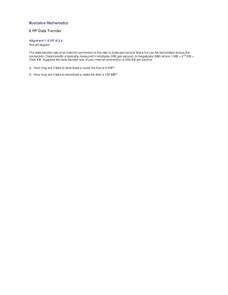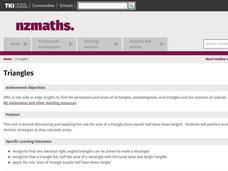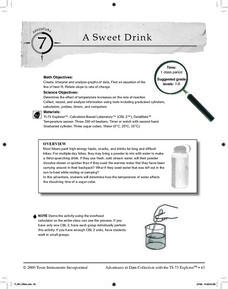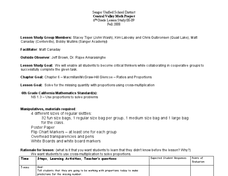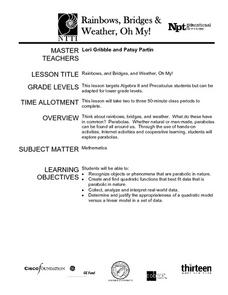Curated OER
Compound Interest
In this consumer math worksheet, learners read an example of how to use the interest formula to compute interest that is compounded daily over six years. They complete a chart where they compute the interest earned over 10 years when the...
Curated OER
Applications And Problem Solving With Inequalities
In this math worksheet, students solve the word problems using inequalities. They translate the words into the correct expressions.
Curated OER
What's Your Hypothesis?
Find the article, "In the Thick of Air Pollution," not through the resource link in the lesson plan, but through an Internet search. Have high schoolers read it and perform calculations with the statistics provided. The objective is to...
Curated OER
Comparing and Ordering Fractions, Mixed Numbers, and Decimals
Students practice comparing and ordering fractions, mixed numbers, and decimals. In this fractions, mixed numbers, and decimals lesson, students examine a decimal place value chart compared to a whole number place value chart. They...
Curated OER
Analyzing Discrete and Continuous Data in a Spreadsheet
You are what you eat! Your statisticians keep a log of what they eat from anywhere between a day to more than a week, keeping track of a variety of nutritional information using a spreadsheet. After analyzing their own data, individuals...
Curated OER
Counting Words in a Sentence
Combine numbers and pre-reading by counting the words in a sentence. Kindergartners begin by counting objects in the room, putting a counter down for each number. Do this a few times to get them confident with the skill before...
Illustrative Mathematics
Riding by the Library
Draw a graph that shows the qualitative features of a function that has been described verbally. Make sure learners understand where time is zero and the distance is zero. It may take them some time to understand this concept, so working...
Illustrative Mathematics
Data Transfer
A question to ask your class is, How fast is your Internet? That depends on the data transfer rate (DTR), which is the unit rate used in this activity. Math students will calculate how long it takes to download a music file and a video...
Curated OER
Best-Selling Books Bar Graph
Pupils fill in bar graphs to show ten of the best-selling students' books of all time. Pupils create simple bar graphs to show how many copies of each of the ten books have been sold.
Curated OER
Toothpick Tops
Students assembly tops and name them 1 - 12 so that they can compare their results. They guess which top they think will spin the best and then record data on "Toothpick Top" table. Using a stopwatch or clock to measure and record the...
Curated OER
The Tilt of the Earth And the Seasons
Fourth graders measure the change in the size of their shadow over time. They visit a fixed structure and record the date, the time, and the measurement of the length of their shadow. They do this over the course of the school year. They...
Illustrative Mathematics
Tides
A very simple example of a functional relationship between depth of water and time is shown here. In fact, it might be more useful to use a coastal tide book to better illustrate this real-world experience. Pupils are to count the number...
Curated OER
Anno's Magic Seeds
Read a tale for your class as they unravel patterns presented in the story using manipulatives. Pause to allow time for discussion and explanation of solutions throughout the story. They write equations or expressions with order of...
Curated OER
In the Ballpark
Students practice estimation skills with the video series "Interactions: Real Math, Real Careers". They complete a hands-on activity for estimating large numbers.
Curated OER
Triangles
This unit enables scholars to apply the rule for area of a triangle (area equals half base times height). They practice multiplication and division strategies as they calculate areas.
Curated OER
Hatchet
Students write about a time when they were in a situation where nature frightened them. They write about how Brian solved the problem of how to start a fire in the story. Students complete a short research paper on one of the plants or...
Curated OER
A Sweet Drink
Learners investigate reaction rates. In this seventh or eighth grade mathematics lesson plan, students collect, record, and analyze data regarding how the temperature of water affects the dissolving time of a sugar...
Curated OER
How Much Is A Million
Help young learners visualize the concept of "a million." To convey concepts of numeration and literacy, they will listen to the book How Much is a Million? by David Schwartz. They should be able to make self-to-text connections....
Curated OER
Using Proportions to Solve Problems
Skittles and math? Pupils will work as a class to determine how many orange Skittles are in a large bag by using proportions. They will problem solve, estimate, and share their thinking. Then, they will each receive a small bag of...
World Wildlife Fund
Take 6
Investigate the various properties of the number six with this elementary math lesson plan. From simple addition, subtraction, multiplication, and division problems to the creation of hexagonal tessellations, this lesson plan covers all...
EngageNY
Advanced Factoring Strategies for Quadratic Expressions (part 2)
What do you do with a difficult-to-factor quadratic expression? This lesson provides the answer. Pupils learn a grouping strategy to help factor trinomials. When guess and check seems too tedious, this method is the "works every...
Curated OER
Where Am I, and How Do I Get Where I am Going?
Students describe geographical places through art, music, writing, and math. They compile information in booklets which may be published.
Curated OER
ExplorA-Pond: 4th Grade Perimeter Estimation
Your geometers are used to finding the perimeter of a square or rectangle, so give them something different this time! With this lesson plan, small groups will receive a picture of a shoreline and calculate the perimeter. The website...
Curated OER
Rainbows, Bridges & Weather, Oh My!
Explore how real-world applications can be parabolic in nature and how to find quadratic functions that best fit data. A number of different examples of modeling parabolas are explored including a student scavenger hunt, the exploration...
Other popular searches
- Time Zone Lesson Maths
- Maths Telling Time Clocks
- Time Maths
- Maths Bus/train Timetables
- Maths Time Lesson
- Maths Time Lesson Plans
- Maths Time Line




